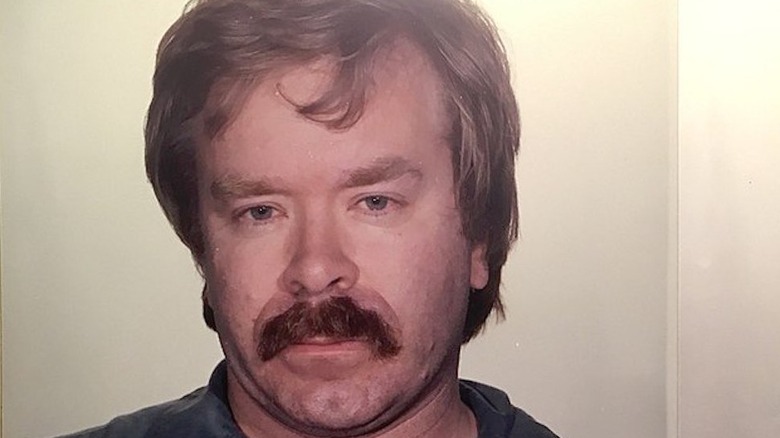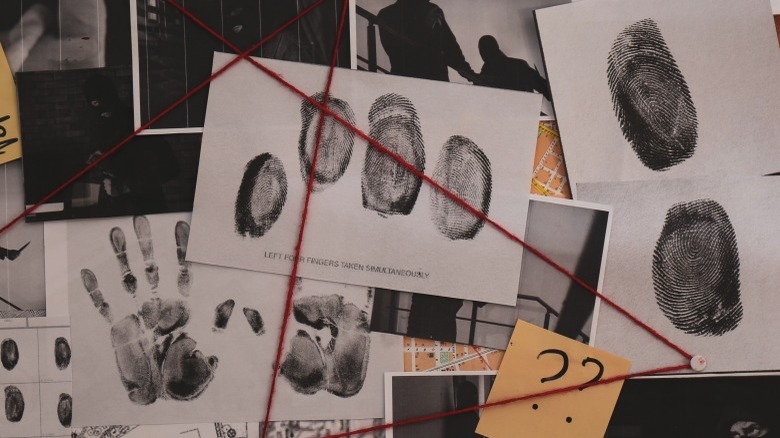The Times Square Killer: The Messed Up Truth
According to crime expert Peter Vronksy (via Rolling Stone), 80% of known serial killers operated between 1970 and 1999, a period that crime hisorian Harold Schechter has referred to as the "golden age of serial murder." Killers active during this period include infamous names such as Jeffrey Dahmer, John Wayne Gacy, Ted Bundy, and Richard Ramirez, who killed their victims in states across the U.S.
Richard Cottingham, the so-called Times Square Killer, is less well known. According to The Independent, New York and New Jersey authorities confirmed that Cottingham, who was also dubbed the Torso Killer, killed at least 11 people from 1967 to 1980. Cottingham earned the moniker because he was known to dismember his victims' corpses, typically removing their heads and hands.
Despite his grotesque crimes, Cottingham had a veneer of normality, maintaining both a job and a family (via Radford University). Meanwhile, he was stalking the streets of Manhattan, with then-sleazy Times Square serving as his twist proving ground. Here is the messed-up truth of Richard Cottingham, the Times Square Killer.
Richard Cottingham's had a normal childhood
As explained by Healthline, in the early 1960s, researcher and psychiatrist J.M. Macdonald established the Macdonald triad, which posits that serial killers often exhibit three childhood behaviors: being cruel to animals, arson, and bedwetting. As a child, Jeffrey Dahmer killed and dissected various animals in the woods by his home (via the Independent). Edmund Kemper shot birds and other animals before murdering his grandparents to "see what it would feel like" (via Biography).
However, Richard Cottingham showed no obvious signs of the evil he was capable of. In fact, Cottingham was said to have an interest in homing pigeons, according to Radford University. He was reportedly a solitary child who would tinker around his mother's garden rather than make friends at his boys' school in River Vale, New Jersey. His loner behavior was not out of the ordinary, though, and he later made friends at Pascack Valley High School. He also became a long distance runner for the school's cross country and track team.
He killed his first victim in 1967
Most serial killers commit their first murder in their late 20s (via Insider). However, Cottingham was just 21 when he murdered his first victim, according to Radford University. In 1967, he strangled to death Nancy Schiava Vogel, a 29-year-old mother of two, inside her vehicle during a visit to Ridgefield Park, New Jersey (via Find a Grave). Earlier that day, Vogel had been playing bingo with her friends when she encountered Cottingham, whom she knew as a fellow Little Ferry resident.
Cottingham would not plead guilty to this crime until 2010. NJ.com reports that Cottingham confessed after a lengthy investigation by County Prosecutor John Molinelli, who visited Cottingham at New Jersey State Prison in Trenton over a period of several years.
Vogel's murder would be followed by three more in 1968 and 1969. According to NJ.com, these early victims were 18-year-old Irene Blase, 15-year-old Denise Falasca, and 13-year-old Jackie Harp. Stubborn and dishonest, Cottingham only admitted these crimes decades later, from 2004 to 2019.
Richard Cottingham was a family man
Cottingham's messed-up crimes took place while he worked as a computer operator, which enabled him to rent a three-bedroom property in New Jersey. He lived there with his wife, Janet, and their three children, Blair, Scott, and Jenny (via Radford University).
In his book "Serial Killers: The Method and Madness of Monsters," (via Murderpedia) Peter Vronsky writes that Cottingham was "steadily employed" for 16 years at the Empire State Blue Cross–Blue Shield insurance company, which was based on Manhattan's Third Avenue. Vronsky reports that Cottingham was a "valued and dependable employee" who preferred the 3 to 11 pm shift. Disturbingly, he reportedly had this preference because it allowed him to find his victims after work, roaming the streets on the other side of Manhattan.
His neighbors had a similarly good impression of Cottingham, whom they described as, "a doting father who always took his children out trick-or-treating on Halloween."
He was charged with assault and robbery
According to Radford University's narrative, Cottingham was charged with a series of crimes in the early 1970s. On August 21, 1972, he was charged, convicted, and fined $50 for shoplifting at Stern's Department Store. Then, on September 4, 1973, Cottingham was charged with robbery, sodomy, and sexual assault, but the case was dismissed. Also dismissed were charges of unlawful imprisonment and robbery on February 12, 1974.
What went completely under the radar was Cottingham's murders of Mary Ann Pryor, 17, and Lorraine Kelly, 16 (via the New York Times). Cottingham abducted and killed the girls on August 14, 1974, dumping their bodies near a parking lot. The police commissioner described the site as, "A horrible scene... like two little dolls at Christmastime."
Cottingham only confessed to this heinous crime in April 2021. Disturbingly, Cottingham said he remembered the girls' names because, "I was with them for a couple of days... and got to know them." The killer explained that he picked them up and said he was taking them to the mall, but took them to a motel instead, where he drowned them in the bath.
This double murder provoked a rare instance of regret in Cottingham. The New York Times reports him as saying "To this day, I don't even think they would have ever said anything. And that's what bothers me, because I probably didn't have to do anything to them."
Richard Cottingham brutally assaulted a pregnant woman
Richard Cottingham's life had detoriated since the birth of Jenny, his third and last child, in October 1976. In his book "Serial Killers: The Method and Madness of Monsters," (via Murderpedia) Peter Vronsky writes that around this time Cottingham started refusing to have sex with his wife and began an affair with a woman named Barbara Lucas. According Michael Newton's "Hunting Humans: An Encyclopedia of Modern Serial Killers," in April 1980, Janet Cottingham filed for divorce citing "extreme cruelty" and accusing her husband of frequenting gay bars in Manhattan (via Murderpedia).
His crimes continued throughout the late 1970s before reaching a frenzied pace in 1980. In December 1977, he bound and strangled Maryann Carr (via Radford University). In September and October 1978, he attacked and raped Karen Schilt and Susan Geiger, the latter of whom was pregnant. Both were dumped and left for dead in New Jersey.
Firefighters 'rescued' one victim
On December 2, 1979, New York firefighters were called to a blaze at the Travel Inn Motor Hotel at 515 West 42nd Street (via Radford University). As they worked through smoke and fire, they found two women. Believing them to be disabled by smoke inhalation, a firefighter carried one of the women to "safety" and was about to administer mouth-to-mouth resuscitation. As the smoke thinned, he realized that the body was missing its head and hands (via All That's Interesting). A 15-year veteran of the fire service, he told Peter Vronsky for "Serial Killers: The Method and Madness of Monsters," that he had "never come across something like that" and that he hoped he never would again (via Murderpedia).
Vronsky happened to be at the hotel that night and actually bumped into Cottingham by the elevator, describing him as a "glassy-eyed zombie" with a "really bad mop-like haircut." The author describes smelling a "faint but distinct odor of something burning," which he dismissed as the natural odor of the scuzzy, downtrodden establishment. However, when he emerged from the elevator, Vronsky was greeted by soot-stained walls and screaming guests, who triggered fire alarms.
The victims were 22-year-old Deedeh Goodarzi and a 16-year-old girl whose identity remains unknown to this day.
In 1980, he went on a killing spree
In May 1980, Richard Cottingham attacked four women with terrible barbarity, killing three of them. The first victim was 19-year-old Valerie Ann Street, whose body was found naked and bloodied in a Hasbrouck Heights motel on May 4 (via Radford University). Second was Pamela Weisenfeld, who Cottingham dumped in a parking lot after drugging, beating, and biting her on May 12. She survived the attack. Third was 25-year-old Jean Reyner, whose body was found stabbed and strangled on May 15. Lastly, the body of Leslie O'Dell, an 18-year-old sex worker, was found tortured on May 22.
Leslie O'Dell was Cottingham's final victim. According to "Serial Killers: The Method and Madness of Monsters," he had seduced her with drinks and a steak dinner, treating her with sympathy and generosity (via Murderpedia). She agreed to have sex with Cottingham for $100, so he brazenly checked in to the Hasbrouck Heights motel, where he had murdered Valerie Ann Street just weeks before. There, he attacked O'Dell for some four hours. Fortunately, her screams were heard by fellow guests, who called the police.
Cottingham attempted to flee but was promptly apprehended. According to "Hunting Humans: An Encyclopedia of Modern Serial Killers" (via Murderpedia), Cottingham was sentenced to over 200 years in prison after separate trials in 1981, 1982, and 1984.
Times Square was the perfect place to commit his crimes
Today, Times Square is the tourist epicenter of New York City, with chain restaurants and upscale hotels. In the 1970s, however, it was a hive of pimps, sleaze, and sex shops.
In 1972, Broadway actress Joan Hackett told the New York Times, "This has always been a fairly tacky area, but it's as evil as it can be now... I was propositioned by girl who looked about 17, and another actress was urinated on by a wino who sits at the stage entrance. Sometimes actresses are literally pulled into doorways. There are panhandlers who hit you if you turn them down."
By the end of New York's crime wave through the 1970s and into the 1980s, Times Square was seeing 2,300 crimes a year, with around a fifth of those being either murder or rape (via The Telegraph). Times Square and New York City became so dangerous that pamphlets titled "WELCOME TO FEAR CITY" were distributed to tourists, whom were strongly advised to keep off the streets after 6 pm. This zone of lawlessness and corruption was perfect for Richard Cottingham, who could prowl the streets and target vulnerable women to maim and murder.
Richard Cottingham made multiple suicide attempts in jail
Richard Cottingham's first suicide attempt was in custody in 1980. According to "Hunting Humans: An Encyclopedia of Modern Serial Killers" (via Murderpedia), Cottingham smashed his glasses and used the glass to slash his wrists, but the attempt was unsuccessful.
He tried a different method on June 14, 1981, shortly after he was convicted of 15 counts of assault, rape, and murder. Locked in his cell at the Bergen County Jail, Cottingham drank six ounces of liquid antidepressant (via Radford University). He survived, and on July 25 was sentenced to 173 to 197 years in state prison.
His third attempt was the most dramatic. While on trial for three more murders on July 6, 1984, Cottingham produced a razor blade and slashed his left forearm in front of jurors. How he obtained this blade is unclear, but he failed to do much damage with it. The trial resumed later that afternoon (via the New York Times).
He is friends with his victim's daughter
Remarkably, the image above is of Richard Cottingham and Jennifer Weiss, the daughter of Deedeh Goodarzi, the 22-year-old woman who was killed, dismembered, and set on fire by Cottingham on December 2, 1979. How could someone befriend a man who had killed and dismemebered their mother? Weiss told NJ.com that, "Everybody deserves to be forgiven... the magnitude of what he did is unfathomable, but I became friends with Richard for my mother's sake and for my quest."
An adopted child, Jennifer's extraordinary goodwill is motivated by a tragic wish — to find her mother's skull. In that dingy motel room in 1979, Cottingham packaged the heads and hands of his two victims into a case and left the building, bumping into the aforementioned Peter Vronsky by the elevator. As described in "Serial Killers: The Method and Madness of Monsters," the case brushed against the author's leg (via Murderpedia). The contents of that case remain unknown, but Jennifer hopes that Cottingham will reveal the truth.
She remembered the first time she came face-to-face with Cottingham, telling NJ.com that "He was sitting there waiting in the window with a sheet of glass between us... the image of him was a little frightening, but I wasn't scared... I was more concerned about finding out about my mom, that was the driving force." Despite visiting Cottingham over 30 times, Jennifer is yet to fulfill her "quest."










